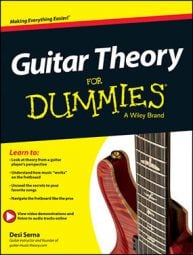On the guitar, Aeolian mode, the sixth mode of the major scale, is the sound that’s created when the 6th scale degree functions as the tonic. Because it features a minor 3rd and centers on a minor chord, it’s a minor mode. It’s better known as the natural or relative minor scale. Rather than being called Aeolian mode, it’s usually referred to as the minor scale.
Drawing from the G major scale, Aeolian mode looks like this:
G major
1-2-3-4-5-6-7
G-A-B-C-D-E-Fs
I-ii-iii-IV-V-vi-viif5
G-Am-Bm-C-D-Em-Fsmf5
E minor
1-2-f3-4-5-f6-f7
E-Fs-G-A-B-C-D
i-iif5-fIII-iv-v-fVI-fVII
Em-Fsmf5-G-Am-Bm-C-D
The minor scale can be thought of as a major scale with a flattened 3rd, 6th, and 7th. Here is how to view the fretboard in E minor, using the notes and chords of G major. The only difference is that the 6th degree, E, is now the tonic and counted as number 1.
![[Credit: Illustration courtesy of Desi Serna]](https://www.dummies.com/wp-content/uploads/420293.image0.jpg)
If you want to play a natural minor scale, play 1 to 1. You can play in other natural minor keys by centering music on the 6th degree of other major scales.
This is just one example of how you can view the fretboard in E minor. In order to properly produce the natural minor sound, you need to use some type of accompaniment, like the one shown here. This vi-ii-iii chord progression in G becomes i-iv-v when you center on Em.
![[Credit: Illustration courtesy of Desi Serna]](https://www.dummies.com/wp-content/uploads/420294.image1.jpg)
You can play along with G major scale notes to produce the sound of E Aeolian mode in E Aeolian Play-Along Track.
Because Aeolian mode centers on a minor chord, you approach it with minor pentatonic scale patterns. You can see how to put together E minor pentatonic and G major scale patterns here.
![[Credit: Illustration courtesy of Desi Serna]](https://www.dummies.com/wp-content/uploads/420295.image2.jpg)
You can think of the minor scale as being the minor pentatonic with an added 2nd and f6th. Because G major and E minor are relative to one another, they both use the same pentatonic and major scale patterns. It’s recommended that you at least play through the combination set in E minor pentatonic pattern 1 beginning at the 12th fret of the 6th string.
Notice that because you start with pentatonic pattern 1 at the 12th fret, the remaining patterns are an octave lower in order to place you in a more comfortable position on the neck. The key of E minor is just a starting point. Move the same patterns around to play Aeolian mode in other keys.
Any time a piece of music uses the major scale and centers on the 6th degree, chord vi, it’s Aeolian mode, better known simply as the minor scale. Some song examples that are either entirely based in Aeolian mode or at least have an Aeolian section include
“Livin’ On a Prayer” by Bon Jovi (E minor)
“Maria Maria” by Santana (A minor)
“Black Magic Woman” by Santana (D minor)
“You Give Love a Bad Name” by Bon Jovi (C minor)
“Smells Like Teen Spirit” by Nirvana (F minor)
“Paranoid” by Black Sabbath (E minor)
“The Thrill Is Gone” by B.B. King (B minor)
“I Shot the Sheriff” by Bob Marley/Eric Clapton (G minor)
“Fade to Black” by Metallica (B minor)
“All Along the Watchtower” by Jimi Hendrix (Cs minor with guitars tuned down one half step to Ef).
Any one of these songs is good for playing along with and practicing Aeolian mode. You can also put together your own tracks by centering a progression around the 6th degree and chord from the major scale.

